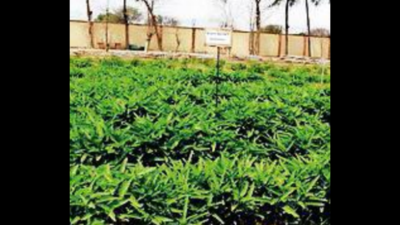- News
- City News
- varanasi News
- IIVR tech to help commercial cultivation of water spinach
Trending Topics
IIVR tech to help commercial cultivation of water spinach

Water spinach developed by Indian Institute of Vegetable Research (IIVR), Varanasi
VARANASI: Water spinach or Kalmi Saag, known to grow in stagnant ponds, water reservoirs has now reached the door of the farmers. With the technology developed by the Indian Institute of Vegetable Research (IIVR), Varanasi, Kalmi Saag is now being commercially cultivated in normal fields like other leafy vegetables.
Earlier, this leafy vegetable used to grow in stagnant ponds, puddles, reservoirs and was relished in various forms, especially during the rainy season. However, the practices led to accumulation of non-nutritious harmful elements in large quantities and also required to get into deep water to harvest the saag.
But now with the new farming technology, this saag can be grown in fields as Kashi Manu, a variety developed by the IIVR. IIVR director Dr Tusar Kanti Behera said that the water spinach is a treasure of nutrition. This variety is grown throughout the year after planting it in the field and the cost of its cultivation is negligible, he said. Cultivation of this crop in large quantities will not only provide nutritious food, but with its medicinal properties, it will add new dimensions.
Principal scientist Rakesh K Dubey, who has developed this variety, said that this crop is a treasure trove of nutrients containing calcium (141.92 mg), iron (59.67 mg), magnesium (462.22 mg), zinc (1.59 mg), protein (197.13 µg) per gram, fibre (2.19 g), Vitamin A (133 mg), calorie (5.9 per 100 g of edible portion) and is also a storehouse of vitamin C, carotene and many other vitamins and minerals.
He said that Kashi Manu is the country’s first variety developed by the institute. Seeds are sown at a distance of 20 cm from line to line and 10 cm from plant to plant throughout the year in normal fields. Once the crop is established, it keeps producing for years. Cutting of leafy biomass is done 2.5 cm above the ground due to which new plants keep growing and 2-3 cuttings can be obtained in a month. On an average, 900-1000 quintals of green leafy vegetables are produced from one hectare.
Dubey said that the vegetable is sold in the market at Rs 20-30 per kg in wholesale price, and thus the farmer can draw an income of Rs 12 to 15 lakh from one hectare even with minimum cost. The seeds of Kashi Manu variety are available at the institute, and are being made available to the farmers. The farmers can easily earn maximum profit by doing commercial farming of his crop. The availability of these greens can be ensured throughout the year by growing this new variety of Kashi Manu in pots on the roofs of houses, in balconies and in kitchen gardens. This variety has got a green signal in the meeting of the central sub-committee on standards, release and notification of Varieties for Horticultural Crops held at Krishi Bhavan, New Delhi.
Earlier, this leafy vegetable used to grow in stagnant ponds, puddles, reservoirs and was relished in various forms, especially during the rainy season. However, the practices led to accumulation of non-nutritious harmful elements in large quantities and also required to get into deep water to harvest the saag.
But now with the new farming technology, this saag can be grown in fields as Kashi Manu, a variety developed by the IIVR. IIVR director Dr Tusar Kanti Behera said that the water spinach is a treasure of nutrition. This variety is grown throughout the year after planting it in the field and the cost of its cultivation is negligible, he said. Cultivation of this crop in large quantities will not only provide nutritious food, but with its medicinal properties, it will add new dimensions.
Principal scientist Rakesh K Dubey, who has developed this variety, said that this crop is a treasure trove of nutrients containing calcium (141.92 mg), iron (59.67 mg), magnesium (462.22 mg), zinc (1.59 mg), protein (197.13 µg) per gram, fibre (2.19 g), Vitamin A (133 mg), calorie (5.9 per 100 g of edible portion) and is also a storehouse of vitamin C, carotene and many other vitamins and minerals.
He said that Kashi Manu is the country’s first variety developed by the institute. Seeds are sown at a distance of 20 cm from line to line and 10 cm from plant to plant throughout the year in normal fields. Once the crop is established, it keeps producing for years. Cutting of leafy biomass is done 2.5 cm above the ground due to which new plants keep growing and 2-3 cuttings can be obtained in a month. On an average, 900-1000 quintals of green leafy vegetables are produced from one hectare.
Dubey said that the vegetable is sold in the market at Rs 20-30 per kg in wholesale price, and thus the farmer can draw an income of Rs 12 to 15 lakh from one hectare even with minimum cost. The seeds of Kashi Manu variety are available at the institute, and are being made available to the farmers. The farmers can easily earn maximum profit by doing commercial farming of his crop. The availability of these greens can be ensured throughout the year by growing this new variety of Kashi Manu in pots on the roofs of houses, in balconies and in kitchen gardens. This variety has got a green signal in the meeting of the central sub-committee on standards, release and notification of Varieties for Horticultural Crops held at Krishi Bhavan, New Delhi.
Start a Conversation
FOLLOW US ON SOCIAL MEDIA
FacebookTwitterInstagramKOO APPYOUTUBE










